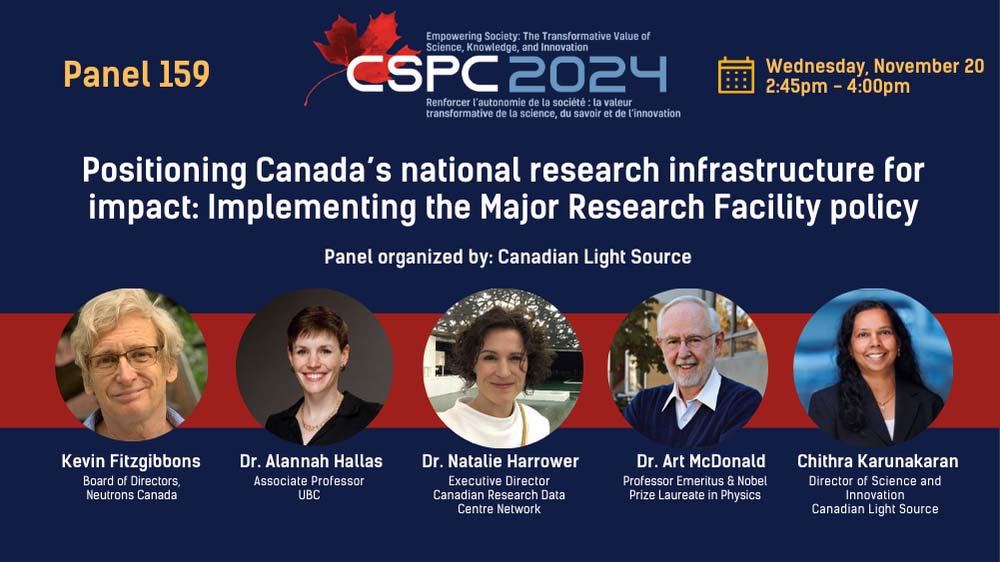Abstract:
Canada’s major research infrastructures (RIs) are critical enablers of the national Science, Technology and Innovation (STI) ecosystem across virtually all science sectors and disciplines and represent a massive investment of the overall STI budget. The new Major Research Facilities (MRF) policy framework is expected to address MRFs as a strategic national portfolio, offering a critical opportunity to strengthen Canada’s approach to RIs and to optimize their impacts. This interactive panel will inspire discussion on how to ensure optimal outcomes from the new MRF policy, what elements may require specific attention, and will inform key considerations for decision makers.
Summary of Conversations
The panel discussed positioning Canada’s national research infrastructure for greater impact through the major research facility framework. Key themes included the need for improved operational and capital funding to maintain state-of-the-art facilities, attract talent, and support researcher training. International partnerships were emphasized, particularly for neutron access, highlighting the importance of formal agreements and collaborations. Discussions also covered the significance of digital infrastructure, data products, and ‘ocean intelligence’. The panel underscored the value of strategic planning, innovation culture promotion, and addressing the structural diversity of research infrastructures, considering disciplinary differences and the integration of social sciences and humanities. A national strategy was proposed, linking research infrastructure to national interests and economic development.
Take Away Messages/ Current Status of Challenges
Here are the key challenges and takeaway messages discussed:
- Funding Gaps: There’s a need for improved and predictable operational and capital funding to sustain major research facilities and prevent reliance on short-term project-based grants.
- International Collaboration: Securing access to international facilities, particularly for neutron research, requires formal agreements and strategic partnerships.
- Digital Infrastructure: Investing in digital infrastructure and data products is crucial for maximizing the impact of research facilities.
- Disciplinary Diversity: A one-size-fits-all approach to funding doesn’t work; the framework must accommodate the unique needs of different disciplines (social sciences, humanities, etc.).
- Defining Impact: Concepts of size, impact, and reach need to be considered from a range of perspectives to avoid excluding valuable research infrastructures.
- National Strategy Void: The absence of a long-term national science and innovation strategy hinders effective planning and resource allocation.
- Transition and Growth: Helping smaller platforms transition to becoming national facilities is challenging due to strategic planning resource limitations.
- Sustainability Concerns: There are concerns about the sustainability of research institutes and the need for long-term thinking.
Recommendations/Next Steps
Here are the recommendations and next steps that were proposed:
- Comprehensive Rd. Mapping: Conduct a comprehensive Canadian National Research Infrastructure Road. mapping exercise alongside framework development.
- Portfolio Approach Implementation: Implement a true portfolio approach that recognizes the diversity of disciplines and research domains.
- Reconsider Thresholds: Reconsider the threshold for designation to ensure inclusivity of varied research infrastructures, especially non-capital-intensive ones.
- Promote Innovation Culture: Foster innovation within major research facilities and collaboration among them, leveraging existing expertise.
- Government Stewardship: Increase government involvement in the stewardship and governance of national research infrastructure.
- International Engagement Strategy: Develop a clear pathway for international engagement, including access to foreign facilities and attracting international talent.
- Connect to National Interest: Connect research infrastructure to national interests and economic development to garner stronger support.
- Address Structural Features: Consideration of structural diversity in the MRF portfolio.
* This summary has been generated with the assistance of AI tools


